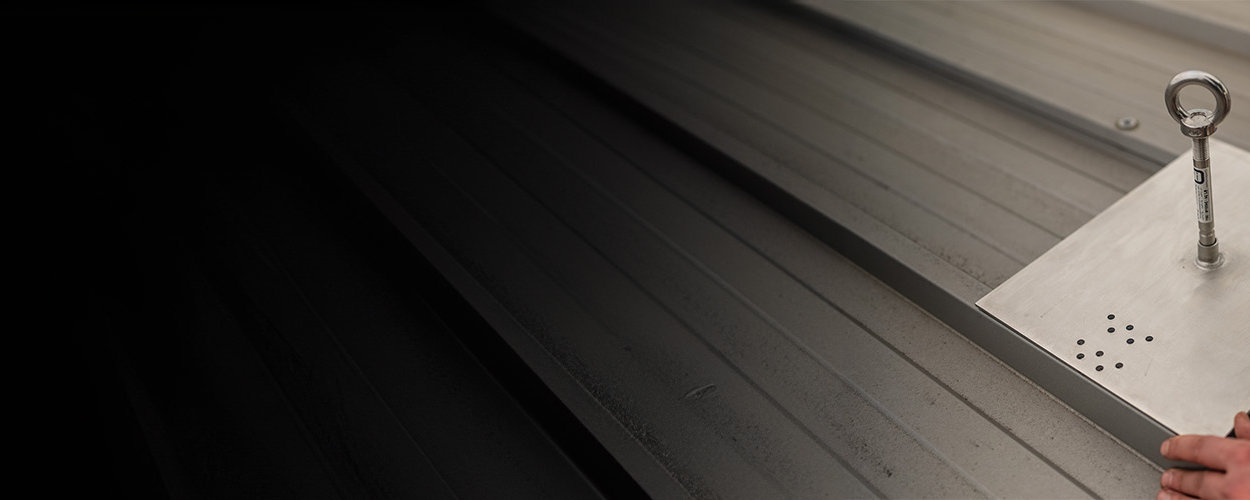What is a falling edge?
A fall edge is the edge over which people can fall. As soon as the potential fall height is one metre, the fall edge and the associated area at risk of falling must be secured.
The technical rules for workplaces (also abbreviated as ASR A2.1) contain a concrete definition. The following points are mentioned here as a basis for classification:
Edge to a surface inclined at more than 60° (e.g. a roof surface): These are generally considered fall edges, regardless of height.
Transition from a surface that is safe to walk through to a surface that is not safe to walk through: There is also a risk of falling here, e.g. with skylight domes on roofs.
Transition of surfaces with different angles of inclination from a surface inclined at up to 20° to a surface inclined at more than 60° or
the imaginary line on curved surfaces from which the angle of inclination of a tangent is greater than 60°.
Would you like to find out more about rules, standards and regulations for fall protection? ► Read the glossary entry now and get an overview of applicable standards and regulations!
Fall edge and area at risk of falling - How do they relate to each other?
The fall edge and the area at risk of falling are closely linked, but describe two different things:
Falling edge
Definition: The edge over which a person or object can fall.
Example: The edge of a roof, the edge of a pit, the edge of a staircase.
Area at risk of falling
Definition: The area where there is a risk of falling over the edge.
Specification: In Germany, ASR A2.1 defines the area at risk of falling as the area that is 2 metres away from the edge of the fall.
Example: The area on a roof that is 2 metres or less from the edge of the roof.
Without a fall edge, there is no area at risk of falling. As a rule, the area at risk of falling starts directly at the edge of the fall and extends 2 metres away from it. In exceptional cases, the fall hazard area may be larger, for example if the surface is uneven or slippery materials have been used.
A person may only stay or carry out work within the area at risk of falling (i.e. closer than 2 metres to the edge of the fall) if the person uses PPE to protect themselves against falling or the consequences of a fall. With a safety harness, workers at height can connect themselves to an anchor point or a rope system using a suitable lanyard and carry out their work safely. Other safety measures include, for example, guardrails and tie-offs. People who are not directly at the edge of the fall can also be at risk in areas where there is a risk of falling, e.g. from falling objects.
Examples of fall edges
- Platforms and stair landings: Ensure non-slip surfaces and stable railings.
- Openings in storey ceilings: Ceiling openings must be adequately covered or fitted with a railing.
- Roof terraces and flat roofs: Only enter authorised areas and use non-slip shoes.
- Pitched roofs, round roofs and cupolas: Work on these roofs may only be carried out by trained persons with appropriate protective equipment.
- Roof openings: Skylight domes and continuous rooflights must be labelled and secured against falling.
In addition to the measures mentioned above, it is also important to regularly check the fall edges for defects and rectify them if necessary.
What is the minimum distance to the fall edge when restraining
Restraint systems should keep the worker back from the edge of the fall and the associated danger zones. Therefore, the minimum distance to the edge of the fall should be 2 metres. If work is carried out in an area where there is a risk of falling, a suitable fall arrest system must be selected. When designing a fall arrest system, suitable PPE components such as shock absorbers should also be used to reduce the risk of injury to the user concerned in the event of a fall. The potential fall height should also always be taken into account.
